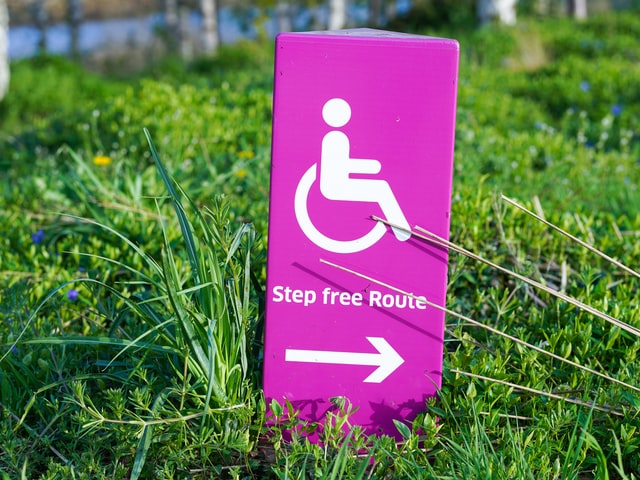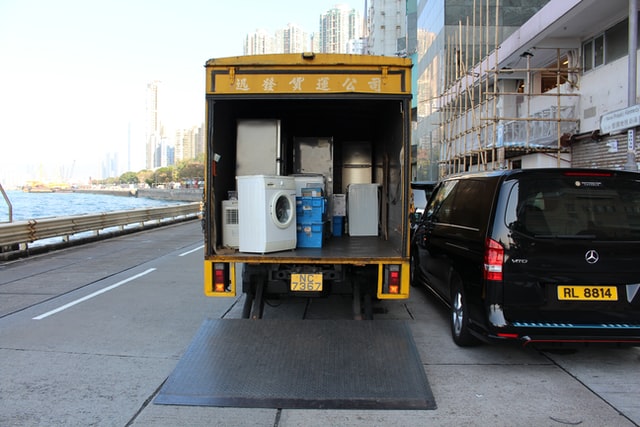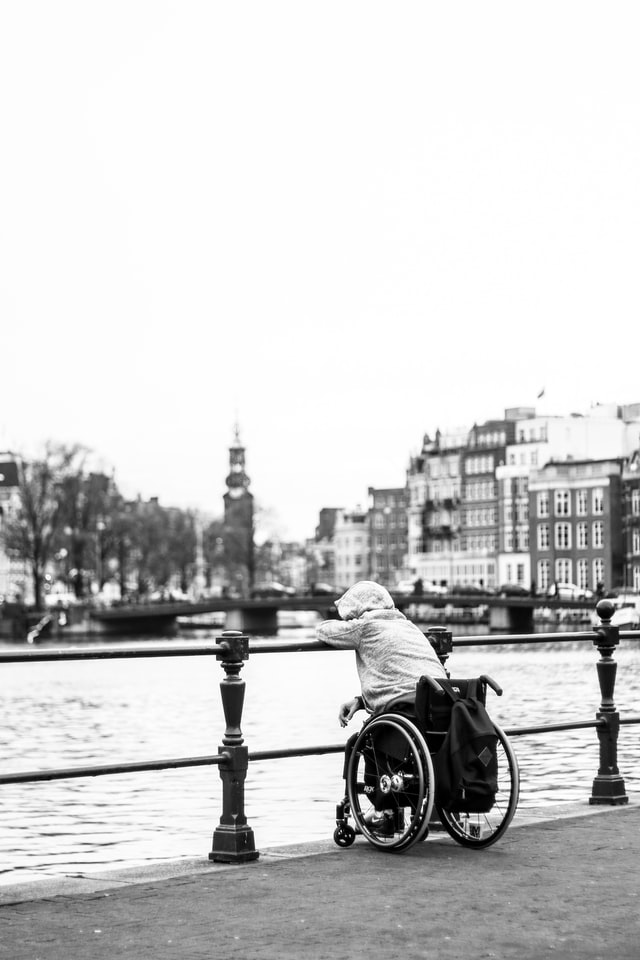Navigating a Move with a Disability
 (We have received quite a few emails from people who are disabled and looking to move. Please, were are not a moving company, and cannot help you with this. But below you will find some great resources that will help you.)
(We have received quite a few emails from people who are disabled and looking to move. Please, were are not a moving company, and cannot help you with this. But below you will find some great resources that will help you.)
Moving assistance for people with disabilities is available to make moving possible for everyone. Like any successful move, it takes a combination of planning, assistance, and care. Instead of letting your move overwhelm you, break it down into an organized list of steps and small tasks.
Moving can be strenuous for anyone, and hiring help is never a bad idea. Professional movers for people with disabilities can work with you to make sure you aren’t in harm’s way throughout the entirety of the process and can be there to help as much or as little as you’d like.
Furthermore, there are specific resources that provide moving help for people with disabilities. Resources such as a relocation grant for people with disabilities provide financial assistance for a move and ensure the new living space is fully accessible. MYMOVE is here with a simple guide to help you discover resources, get help with moving for seniors with disabilities, and learn what to do to ensure a smooth move.
Make sure your new home is accessible
Before you begin packing up and moving from one home to another, you need to make sure your new living space is accessible and meets your needs.
 Start with a home accessibility checklist
Start with a home accessibility checklist
When it comes to accessibility, your home should make it easy for you to move around, use the bathroom, and go about your daily life. Assessing your home may feel overwhelming, but you can start with this dedicated home accessibility checklist to analyze your living space. It covers everything from ramps and slopes, parking, entryways and halls, bathrooms, bedrooms, and more. Depending on your disability, you may not need to make every single update on this checklist. But know that it’s a good way to keep track of everything you should be thinking about for your new space.
Hire specialized professionals to make accessibility updates
If you need to make modifications in your new home, hire professionals who can successfully complete the work. Organizations or companies like the UDS Foundation can provide moving assistance for people with disabilities. The UDS Foundation provides aid with individual assessments, home evaluations, and helps with construction and installation. You can also find independent contractors through services like Home Advisor. Though these contractors may not work solely in accessibility improvements, you can provide your list of needs to see what they’ve had experience working on before.
A relocation grant for people with disabilities could help with moving expenses. The US Department of Agriculture (USDA) Rural Development program provides grants and loans to homeowners living or moving to rural areas. If you’re thinking about moving to a rural area, consider a USDA loan or grant. You can use the money to make necessary home modifications and accommodations.
 Know your renters’ rights
Know your renters’ rights
If you’re moving into a rental, it’s important to understand your rights surrounding your relationship with the landlord and what you’re permitted to modify or update in your living space. The Fair Housing Act provides protections and moving help for people with disabilities. Your landlord may not discriminate based on your disability or ask discriminatory questions surrounding it. If you feel like this could be a problem where you’re moving, consider consulting with an attorney about your options.
Tenants with a disability also have the right to request accommodations that are directly associated with their disability. This can include accommodations like living with a service animal or having a dedicated parking spot close by.
It’s generally legal for tenants with disabilities to make modifications and updates to the rental unit to accommodate their needs. Common modifications include adding a wheelchair ramp or installing special handles on doors.
These modifications, however, must be approved by your landlord. If your landlord thinks the modifications will create an “inappropriate living condition” for the next tenant, you may be asked to remove the modifications when you move out. To get your proposed modifications approved, you may need to provide proof of your disability and a description of the changes.
Double-check your insurance, state services, and other forms of disability assistance
If you’re moving to a different state, you may want to check with your insurance providers and other organizations to ensure you can retain the same disability services and help with moving for seniors with disabilities.
 Social Security
Social Security
If you use Social Security Disability Insurance or Supplemental Security Income, there’s no need to worry about what happens when you move. As long as you’re moving within the United States, federal funding stays with you from state to state. You won’t need to reapply for social security, though you’ll need to notify the Social Security Administration about your address change and new living arrangements.
Private insurance or state services
With private insurance, you’ll need to call your insurance provider and let them know about your move and any changes to your living arrangements. You’ll likely need to update your policy, though rates could vary depending on if you’re working and where you’ll be moving.
If you use state services for your disability, you’ll need to reapply for them in your new state. This process should be similar to what you’ve gone through before, but you should double-check with your new state government to ensure you have all the proper paperwork you need to apply.
Medicaid
States have different requirements for who can qualify for Medicaid. If Medicaid ensures you or a loved one and you’re planning to move to another state, make sure you terminate your current Medicaid plan before you leave. Medicaid can’t be transferred — you’ll need to apply for Medicaid in the new state you’re moving to.
Financial assistance for moving with a disability
If you’re in need of financial assistance and moving help for people with disabilities, there are a variety of resources — as well as the possibility of a relocation grant for people with disabilities — that you can apply for.
Here are some links to helpful financial resources:
1. Grants.gov
This is a great site to start with when searching for government grants. On the site, you can custom search for grants related to your disability. Keep in mind that the site adds new grants periodically. Make sure to check back even if you haven’t found anything right away.
The EDL is a 501c3 registered charity that provides help with moving for seniors with disabilities and financial assistance for low-income seniors or people with disabilities. The application process is free and starts with a simple registration online.
3. The Administration for Children & Families
This resource connects you to government financial assistance. The agency offers grants for families, children, individuals, and communities. Many of these grants can also be found on the grants.gov site, but the agency website has more information about specific government loans and resources.
4. The Administration for Community Living (ACL)
The ACL provides grants and funding to institutions that assist aging adults with disabilities. Although they don’t provide individual help with moving for seniors with disabilities, the organization provides a webpage of resources and moving assistance for people with disabilities.
5. The Department of Veterans Affairs
The VA can provide moving help for people with disabilities (if the individual is a veteran) by providing financial assistance to purchase a vehicle with adaptive equipment or to make modifications to an existing one.
 9 moving tips to help you get organized before and after moving day
9 moving tips to help you get organized before and after moving day
The more you plan and organize, the smoother your move will be. Creating a to-do list can help ease the stress of an otherwise busy time period. Try using our seven moving steps to make moving with a disability an easier process:
1. Hire the right mover
Packing for a move is a physically demanding process. Hiring a mover could take much stress and pressure off your shoulders. Make sure to research moving companies for people with disabilities. Look for movers who understand your or your loved one’s special needs and can make the experience seamless. Be sure to interview at least two or three movers, compare price quotes, and check references before you decide.
2. Create a moving checklist
Creating a moving checklist can help you track your tasks and ensure you aren’t missing anything. You can create a personalized online checklist when you sign up with MYMOVE!
3. Budget for the move
Create a ballpark of your moving expenses a few months ahead of time. They may include the moving fee, insurance coverage, travel fees, gas, transportation costs (if you’re driving a long distance), hotel stays, and more. If you’re worried about how you will afford the move, look into a relocation grant for people with disabilities or other types of financial assistance and apply right away.
 4. Get rid of unnecessary clutter
4. Get rid of unnecessary clutter
Leading up to your move, focus on decluttering and getting rid of everything you don’t need. Your move will go by even faster as long as you focus on the necessities. Getting rid of the excess will make your new home feel organized and refreshed.
5. Make a home inventory
Moving can be hectic no matter how much you prepare — and this is also magnified if there are movers coming in and out of your home. Preparing a home inventory helps you keep track of everything you own so you know exactly what’s coming with you to your new place. It’s especially important to create the inventory after you’ve decluttered so you can remember what you’ve gotten rid of and what should be in your new home.
6. Pack light
As you begin packing things into boxes, pay attention to the weight as you go. Even if you’ve hired movers for people with disabilities and won’t be the ones picking up the boxes, it’s usually easier for everyone to move faster with lighter boxes. If it’s too light, the movers can always stack two boxes on top of each other. When it’s too heavy, though, it will take longer to move, and your box could break.
7. Prepare an essentials box
Once you get everything into your new home, settling and can feel even more hectic than the move. To minimize stress, pack an essentials box for your first week or so in the new home when everything still needs to be unpacked and organized. This should include basics like clothes, toiletries, books, and linens, but it also needs to include anything that will make you feel more comfortable.
Don’t forget any medicines you may need, and make sure you have easy access to wheelchair accessories and anything else you’re used to having on a daily basis.
8. Plan for a final walk-through with your movers
If you’ve hired movers or have people helping you, make sure you do a final walk-through before they head out. Make sure you can handle everything left after Moving Day. If the furniture isn’t in the right places, you’ll need the movers to help you put everything in the right spot. If you’re unable to unpack, movers can do that for you. Before they leave, just be sure everything has been unpacked properly, and nothing’s been forgotten.
9. Organize as you unpack
After the big move, unpack little by little so you don’t get overwhelmed. Start with your essentials box, then keep going in order of importance. If you love to cook, unpack your kitchen first. On the other hand, if you want to make your living room feel at home, start with your TV and entertainment center so you can relax.
Hire the right moving company
Hiring movers for people with disabilities may be a necessity. If you have loved ones helping you out, that’s great. But professional movers are still the way to go to make the move as quick, safe, and efficient as possible.
But it’s important to find the right moving company — one that has experience helping people with disabilities move. You should find a company that can move special equipment, such as wheelchairs, CPAP machines, lift chairs, and more. They’ll provide extra care and can even help you put some equipment back together if it requires disassembly to move.
When you’re looking to hire a moving company, do some research. Make sure they’ve provided help with moving for seniors with disabilities in the past and are experienced in the special needs people with disabilities have. Ask them if they specialize in moving certain equipment. It could make the difference between a good and great moving experience.
Questions for the moving company:
Before hiring a moving company, be sure to ask them:
- Is your company licensed?
- Have you helped a person with a disability move before?
- What types of equipment have you handled in a move?
- What are your cleanup procedures once the move is over?
- Will you bring extra ramps and protective gear for special equipment?
- Are the movers able to help unpack if needed? If so, is there an additional fee?
- Can the movers put together medical equipment?
- Do you have any references I could contact?
- What happens if items are lost and damaged?
- What kind of liability coverage do you provide?
- Are you running any applicable promotions or discounts?
You may not feel the need to ask all of these questions, but they can help give you an idea of the moving company’s expertise in helping people with disabilities move. You’ll also get an understanding of their level of professionalism, so you’re not in a lurch if the movers are delayed or valuables are damaged or missing.
The bottom line
Moving with a disability requires the same amount of planning and preparation as any other move. However, you do need to take a little extra care to make sure you’re comfortable before, during, and after the move.
Packing and moving is a physically and mentally strenuous task. Moving assistance for people with disabilities is crucial to make the move easier. And the right movers for people with disabilities can be a vital part of making the transition from the old home to the new one smoother.
Make sure you get the help you need and have all your ducks in a row well ahead of your moving day. Look for funding, such as a relocation grant for people with disabilities if you’re unable to pay for the move or for the improvements to create a more accessible new home. Following MYMOVE’s moving steps and creating a custom checklist is well worth it in the long run when you can finally relax in your new home.
Cynthia Bowman contributed to this post.
Claire Bough is a Nashville-based writer who has experience creating content for a variety of topics, including pest control, senior living, insurance, and finance. Some of her published works include pieces on bankrate.com and mymove.com. Off the computer, you can find her enjoying the outdoors or attempting a new hobby.







 2.
2.